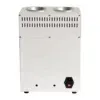 English
English


Evaluation and Calibration Procedures for Current Transformer Testing and Commissioning Processes
Testing and Commissioning of Current Transformers
Current transformers (CTs) play a vital role in electrical systems by providing accurate measurement of current from high-voltage lines. They reduce high currents to manageable levels for the protection and monitoring of electrical equipment. To ensure the reliability and safety of CTs, thorough testing and commissioning processes are essential. This article discusses the importance of testing and commissioning current transformers, the techniques employed, and the key considerations for successful implementation.
Importance of Testing and Commissioning
The accuracy and functionality of current transformers are critical for the protection of electrical systems. Miscalculations in current measurement can lead to incorrect operation of protective devices, potentially resulting in equipment damage and safety hazards. Therefore, testing and commissioning serve as essential processes to verify that CTs function properly before they are put into service. This establishes confidence in both the measurement and protection systems.
Testing Procedures
Several tests are commonly conducted during the commissioning of current transformers
1. Ratio Testing This test checks the transformation ratio of the CT by comparing the primary current to the secondary current. A dedicated ratio test set can apply a known primary current and measure the resultant secondary output, ensuring it meets the manufacturer’s specifications.
2. Polarity Testing Proper polarity is crucial for the correct operation of protection systems. This test verifies that the primary winding and secondary winding are correctly connected. A simple method involves injecting current into the primary winding and observing the direction of the current in the secondary winding.
testing and commissioning of current transformer

3. Insulation Resistance Testing CTs must have adequate insulation to prevent electrical failures. An insulation resistance tester evaluates the integrity of the insulation by applying a high voltage across the windings and measuring the resistance. Adequate insulation resistance readings ensure the safety and reliability of the CT.
4. Burden Testing This test ensures the CT can handle the connected load without performance degradation. By connecting a known burden (or load) to the secondary circuit and measuring the output, technicians can confirm the CT operates efficiently under expected operating conditions.
5. Frequency Response Testing Some applications may require testing the frequency response of the CT to ensure it operates effectively across various frequencies. This test can elucidate the CT’s behavior in different operating conditions.
Key Considerations in Commissioning
While testing is detailed and critical, commissioning should also include careful consideration of installation practices. Proper alignment, mounting, and connection of CTs are paramount to achieving optimal performance. Any physical issues can impede accuracy. Additionally, ensuring that protective settings in connected devices are calibrated according to CT ratings is crucial for system integrity.
When commissioning new CTs, it is advisable to maintain thorough documentation of all testing procedures and results. This creates a useful reference for future maintenance or troubleshooting and ensures adherence to regulatory standards.
Conclusion
The testing and commissioning of current transformers are essential steps in ensuring the safe and reliable operation of electrical systems. By employing comprehensive testing methods, proper installation practices, and meticulous documentation, engineers can significantly mitigate risks associated with current measurement errors. This proactive approach enhances the performance and longevity of electrical systems, safeguarding both equipment and personnel in the field.
-
Differences between open cup flash point tester and closed cup flash point testerNewsOct.31,2024
-
The Reliable Load Tap ChangerNewsOct.23,2024
-
The Essential Guide to Hipot TestersNewsOct.23,2024
-
The Digital Insulation TesterNewsOct.23,2024
-
The Best Earth Loop Impedance Tester for SaleNewsOct.23,2024
-
Tan Delta Tester--The Essential Tool for Electrical Insulation TestingNewsOct.23,2024





